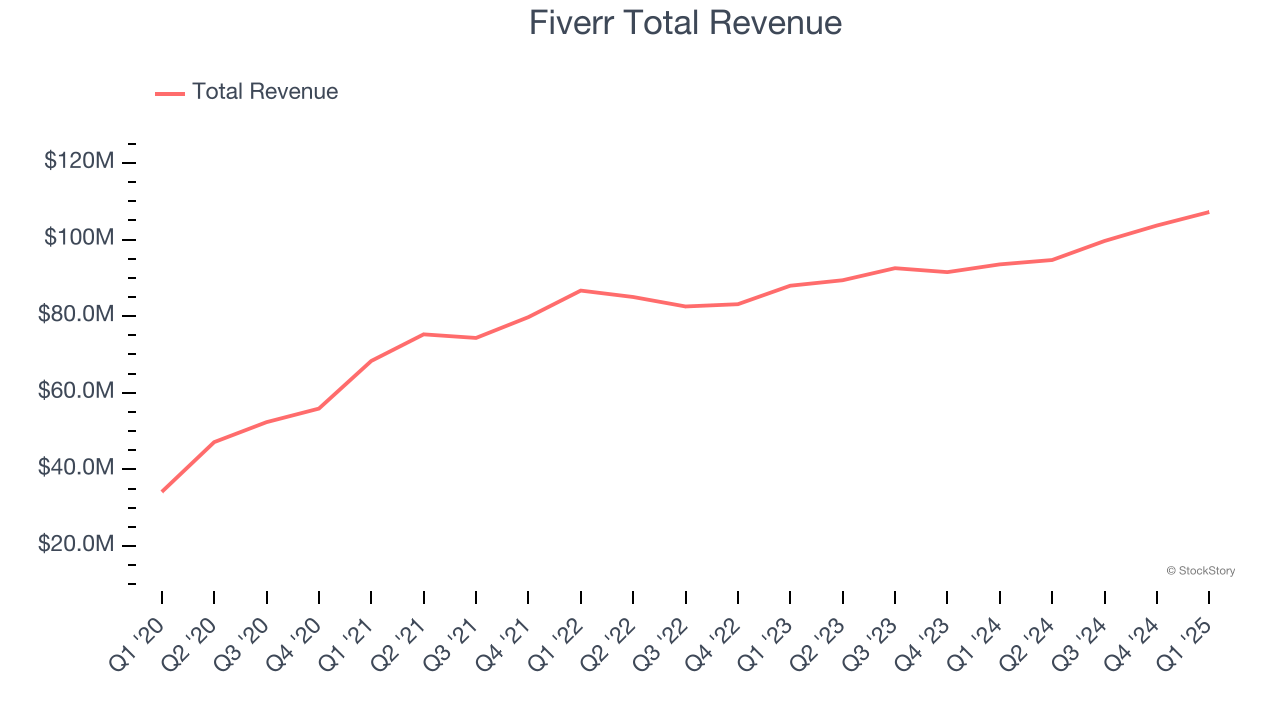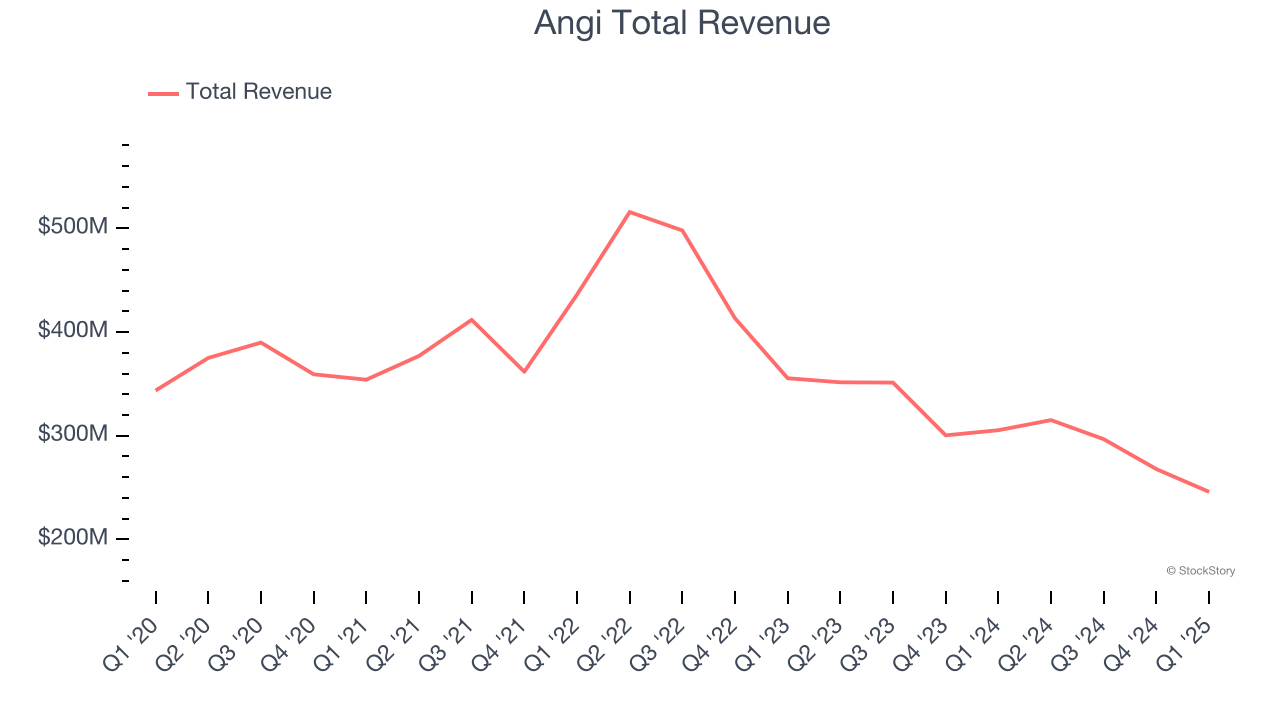
As the Q1 earnings season comes to a close, it’s time to take stock of this quarter’s best and worst performers in the gig economy industry, including Fiverr (NYSE: FVRR) and its peers.
The iPhone changed the world, ushering in the era of the “always-on” internet and “on-demand” services - anything someone could want is just a few taps away. Likewise, the gig economy sprang up in a similar fashion, with a proliferation of tech-enabled freelance labor marketplaces, which work hand and hand with many on demand services. Individuals can now work on demand too. What began with tech-enabled platforms that aggregated riders and drivers has expanded over the past decade to include food delivery, groceries, and now even a plumber or graphic designer are all just a few taps away.
The 6 gig economy stocks we track reported a mixed Q1. As a group, revenues were in line with analysts’ consensus estimates while next quarter’s revenue guidance was 0.6% below.
Luckily, gig economy stocks have performed well with share prices up 19.7% on average since the latest earnings results.
Fiverr (NYSE: FVRR)
Based in Tel Aviv, Fiverr (NYSE: FVRR) operates a fixed price global freelance marketplace for digital services.
Fiverr reported revenues of $107.2 million, up 14.6% year on year. This print exceeded analysts’ expectations by 1%. Despite the top-line beat, it was still a slower quarter for the company with a slight miss of analysts’ number of active buyers estimates.
“The year started off on a strong note with focused execution, as revenue and margins came in ahead of expectations. We continue to deliver stable Marketplace performance, robust Services revenue growth, and rapid AI product expansion. Following our recent successful Fiverr Go launch, we are seeing positive signs on buyer conversion, with buyers converting more and faster, as well as making more quality purchase decisions,” said Micha Kaufman, founder and CEO of Fiverr.

Fiverr scored the highest full-year guidance raise of the whole group. The company reported 3.54 million active buyers, down 11.6% year on year. Unsurprisingly, the stock is up 17.6% since reporting and currently trades at $31.47.
Is now the time to buy Fiverr? Access our full analysis of the earnings results here, it’s free.
Best Q1: Angi (NASDAQ: ANGI)
Created by IAC’s mergers of Angie’s List and HomeAdvisor, ANGI (NASDAQ: ANGI) operates the largest online marketplace for home services in the US.
Angi reported revenues of $245.9 million, down 19.5% year on year, outperforming analysts’ expectations by 2.7%. The business had a strong quarter with an impressive beat of analysts’ EBITDA estimates and a decent beat of analysts’ number of service requests estimates.

Angi achieved the biggest analyst estimates beat among its peers. On a dimmer note, the company reported 3.36 million service requests, down 18.5% year on year. The market seems happy with the results as the stock is up 45.6% since reporting. It currently trades at $16.38.
Is now the time to buy Angi? Access our full analysis of the earnings results here, it’s free.
Weakest Q1: DoorDash (NASDAQ: DASH)
Founded by Stanford students with the intent to build “the local, on-demand FedEx", DoorDash (NYSE: DASH) operates an on-demand food delivery platform.
DoorDash reported revenues of $3.03 billion, up 20.7% year on year, falling short of analysts’ expectations by 2.1%. It was a slower quarter as it posted EBITDA guidance for next quarter missing analysts’ expectations.
DoorDash delivered the fastest revenue growth but had the weakest performance against analyst estimates in the group. The company reported 732 million service requests, up 18.1% year on year. As expected, the stock is down 3.1% since the results and currently trades at $199.
Read our full analysis of DoorDash’s results here.
Uber (NYSE: UBER)
Notoriously funded with $7.7 billion from the Softbank Vision Fund, Uber (NYSE: UBER) operates a platform of on-demand services such as ride-hailing, food delivery, and freight.
Uber reported revenues of $11.53 billion, up 13.8% year on year. This result came in 0.5% below analysts' expectations. All in all, it was a mixed quarter for the company.
The company reported 170 million users, up 14.1% year on year. The stock is up 4.7% since reporting and currently trades at $89.90.
Read our full, actionable report on Uber here, it’s free.
Lyft (NASDAQ: LYFT)
Founded by Logan Green and John Zimmer as a long-distance intercity carpooling company Zimride, Lyft (NASDAQ: LYFT) operates a ridesharing network in the US and Canada.
Lyft reported revenues of $1.45 billion, up 13.5% year on year. This number lagged analysts' expectations by 1.3%. Overall, it was a mixed quarter for the company.
The company reported 24.2 million users, up 10.5% year on year. The stock is up 26.4% since reporting and currently trades at $16.45.
Read our full, actionable report on Lyft here, it’s free.
Market Update
Thanks to the Fed’s series of rate hikes in 2022 and 2023, inflation has cooled significantly from its post-pandemic highs, drawing closer to the 2% goal. This disinflation has occurred without severely impacting economic growth, suggesting the success of a soft landing. The stock market thrived in 2024, spurred by recent rate cuts (0.5% in September and 0.25% in November), and a notable surge followed Donald Trump’s presidential election win in November, propelling indices to historic highs. Nonetheless, the outlook for 2025 remains clouded by potential trade policy changes and corporate tax discussions, which could impact business confidence and growth. The path forward holds both optimism and caution as new policies take shape.
Want to invest in winners with rock-solid fundamentals? Check out our Top 5 Quality Compounder Stocks and add them to your watchlist. These companies are poised for growth regardless of the political or macroeconomic climate.
Join Paid Stock Investor Research
Help us make StockStory more helpful to investors like yourself. Join our paid user research session and receive a $50 Amazon gift card for your opinions. Sign up here.




